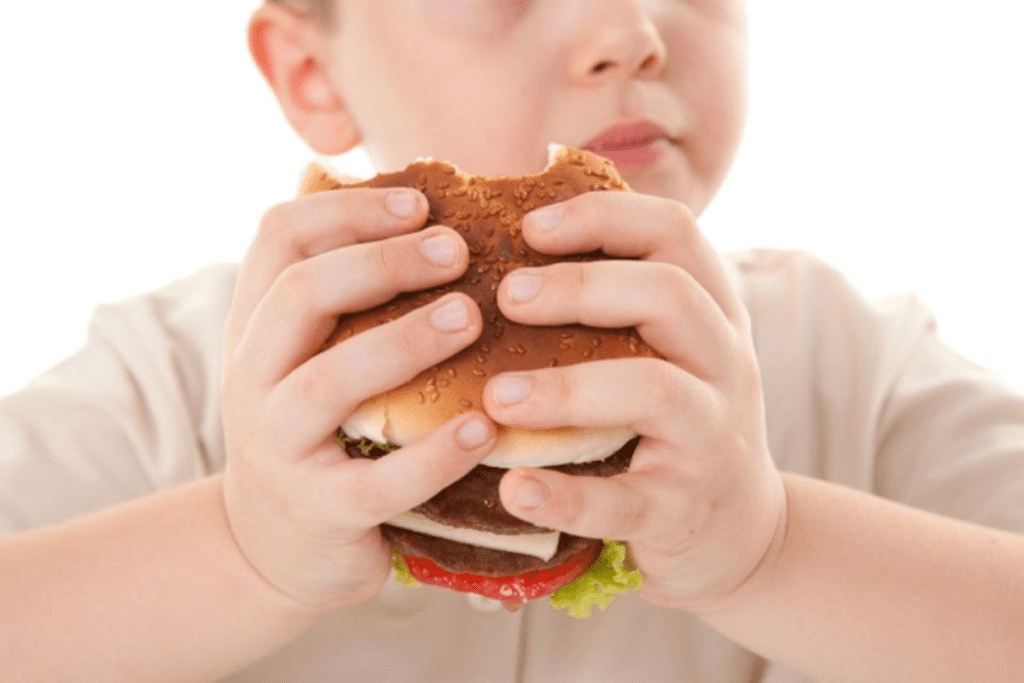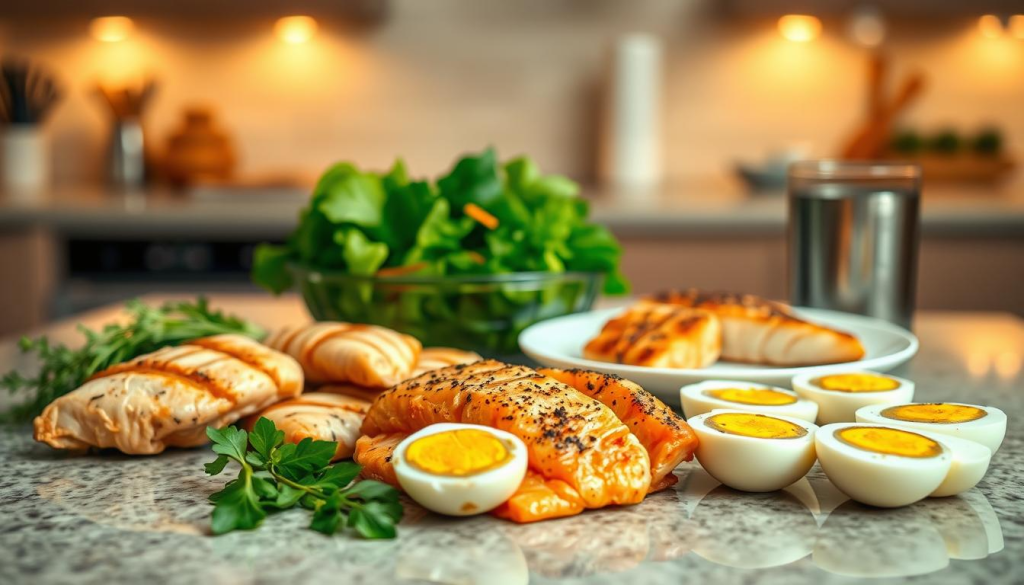Last Updated on November 14, 2025 by

Stopping child obesity needs a mix of diet changes, more exercise, and lifestyle tweaks. Knowing how important nutrition is is the first step to fight obesity.
Foods full of fiber, vitamins, and nutrients are key to a healthy weight. Fresh fruits, veggies, whole grains, lean proteins, and healthy fats are great. They help fight child obesity.
Adding these foods to a child’s diet can lower health risks like asthma, sleep apnea, and type 2 diabetes.

It’s important to understand the childhood obesity problem in the U.S. to find ways to stop it. Obesity in kids is a big health issue that needs quick action.
About 1 in 5 American kids is obese. This increases their risk for health problems like asthma and diabetes. By 2025, only 66.6% of kids will eat fruit every day, and just 49.1% will eat veggies. High sugar drink intake also raises obesity risk.
Children with obesity face serious health issues. Their diet is a big part of the problem. Eating too little fruit and veggies and too much sugar is a major factor.
Diet is key in the childhood obesity crisis. Kids who eat less fruit and veggies and more sugary drinks are at higher risk. Important dietary factors include:
Changing these dietary habits is vital to fighting childhood obesity.
Nutrition is key in preventing childhood obesity. Parents and caregivers can help kids eat healthy by focusing on whole foods. Important nutritional strategies include:
By using these strategies, we can prevent childhood obesity and improve kids’ health.
Fruits and vegetables are key in preventing childhood obesity. We’ll see how they can be added to kids’ diets to fight obesity.
Many reasons lead to low fruit intake in U.S. kids. These include a lack of access, a preference for processed foods, and not knowing the benefits. Increasing access to a variety of fruits can boost consumption. For example, having fruits at home and in schools can encourage daily eating.
To get kids to eat more veggies, we can make them more appealing. This can be done by adding them to dishes in creative ways, like in pasta sauces or soups. Also, getting kids involved in cooking can spark their interest in eating veggies.
For picky eaters, start with mild flavours and soft textures. Bananas, applesauce, and cooked carrots are often liked. Slowly introducing new foods can help them try more.
There are many ways to add more fruits and veggies to kids’ diets. Ideas include making fruit salads, creating veggie snacks like carrot sticks with hummus, and blending fruits into smoothies. Engaging children in meal planning and cooking can also encourage them to try new foods.
Whole grains and fibre are key in fighting childhood obesity. They offer many health benefits that help control weight and improve well-being. Adding whole grains to a child’s diet is a big step towards better eating habits.
Fibre is important for weight management. It helps control hunger and prevent eating too much. Foods high in fibre make you feel full, which can lower calorie intake. We suggest eating more fibre-rich foods to help kids manage their weight.
Fibre does more than just control hunger. It also helps with digestion and bowel health. This can improve overall health and lower the risk of obesity-related problems.
It’s easy to add whole grains to a child’s diet with the right choices. Some great options include:
These foods are not only high in fibre but also packed with nutrients like iron and B vitamins. They make meals more nutritious.
Switching to whole grains can be done slowly. Start by replacing half of refined grains with whole grains. For example, mix whole-wheat bread with white bread or brown rice with white rice.
By making these changes, kids can learn to like whole grains. It becomes a regular part of their diet.
Lean proteins like fish and poultry are key for healthy growth in kids. They help avoid obesity. A balanced diet with lean proteins is great for a child’s health and growth.

Eating lots of veggies, fruits, and fish is good for kids’ weight. Fish and poultry are full of protein and important nutrients. They help with growth and development.
For kids who don’t eat fish or poultry, or for those on a plant-based diet, there are many protein sources. Beans, lentils, tofu, and nuts are good options.
Some excellent plant-based protein options include:
It’s not just about eating lean proteins. The right amount and how often is also important. The daily protein needs depend on age, weight, and how active a child is.
Children need about 0.5 to 0.8 grams of protein for every pound of body weight each day. For example, a 50-pound child might need 25-40 grams of protein every day.
It’s best to talk to a healthcare provider or a nutritionist to figure out your child’s protein needs.
Healthy fats are key in fighting childhood obesity. It’s important to know the difference between fats and their effects on kids’ health.
Nuts, seeds, and olive oil are full of good fats. They help keep kids healthy and can prevent obesity. These foods taste great and are full of nutrients.
Nuts like almonds and walnuts are good for your heart. They make you feel full, helping you eat less. Olive oil is also great, thanks to its healthy fats. It’s perfect for cooking and dressings.
Seeds like chia and flax are full of omega-3s and fibre. They’re good for your brain and body.
Omega-3s are found in fish, nuts, and seeds. They help with weight control. They reduce inflammation, improve insulin use, and support brain health.
Studies show omega-3s can help kids lose weight and get healthier. They improve body shape and function.
To stop childhood obesity, we need to swap bad fats for good ones. We should cut down on saturated and trans fats in processed foods. Choose baked or grilled foods over fried ones.
By picking the right fats for our kids, we can improve their health. Adding nuts, seeds, and olive oil, and making sure they get enough omega-3s, is a good start.
Ultra-processed foods are a big problem in childhood obesity worldwide. They are replacing healthy foods and causing more kids to be overweight. We must understand how these foods affect kids’ health and find ways to fight this issue.
Eating too many processed snacks and refined grains can make kids 2.7 times more likely to be obese, mainly girls. These foods are full of unhealthy fats, added sugars, and sodium, but lack nutrients. Eating them often can make kids eat more and gain weight because they have lots of calories, but they don’t make you feel full.
Key factors contributing to the increased obesity odds include:
To fight childhood obesity, we must know and avoid bad ultra-processed foods. These are things like packaged snacks, sugary drinks, and refined grains. We can do this by reading food labels and picking products with fewer ingredients and less sugar.
Tips for avoiding ultra-processed foods:
Switching to healthier options is a good way to lower childhood obesity. Instead of packaged snacks, try fruits, nuts, or carrot sticks with hummus. These simple changes can make a big difference in kids’ diets.
Healthier alternatives include:
By cutting down on ultra-processed foods and promoting better eating, we can tackle the childhood obesity crisis. This will help ensure a healthier future for our kids.
Creating a healthy eating pattern for kids is more than just food. It’s about regular exercise, less screen time, and a supportive home. When families eat healthy together, kids are more likely to stay healthy as they grow.
Eating a variety of foods like veggies, fruits, whole grains, and lean proteins is key. These foods follow nutrition guidelines and help kids stay healthy. Combining healthy eating with exercise and policies that limit food ads to kids is effective. We can teach kids to make healthy choices by creating a supportive environment.
By making healthy choices a family affair, we give our kids the best start. A healthy eating pattern is about more than just food. It’s about a long-term approach to eating well that benefits everyone in the family.
Childhood obesity is often linked to eating too much of unhealthy food. This includes sugary drinks and foods high in salt and sugar. Kids also don’t eat enough fruits, veggies, whole grains, and lean proteins.
Make fruits and veggies easy to grab and fun to eat. Try cutting them into shapes or serving them with dips. It’s also good to lead by example and let kids help pick and prepare them.
Instead of junk snacks, offer fruits, cut veggies with hummus, nuts, and seeds. Homemade trail mix with whole grains and dried fruits is also a great choice. Having healthy snacks ready can help avoid unhealthy options.
Whole grains are full of fibre, which helps control hunger and prevent overeating. They are also more filling and packed with nutrients, helping kids stay balanced.
Lean proteins are key to healthy growth and development in kids. They help build muscles and organs and keep kids full, reducing the chance of overeating.
Yes, healthy fats are good for kids. They support brain growth, vitamin absorption, and healthy skin. Foods like nuts, seeds, and olive oil are great for a balanced diet.
A healthy eating pattern is more than just food. It includes regular exercise, less screen time, and a supportive home. Getting the whole family involved and making small changes can help keep a healthy lifestyle.
Start by mixing half whole grains with half refined grains. Gradually increase whole grains. Choose whole-grain products that taste and feel similar to what your child is used to.
Read food labels carefully. Look for long lists of ingredients, added preservatives, and high amounts of sugar, salt, and unhealthy fats. Opt for whole, nutrient-dense foods to avoid ultra-processed ones.
Subscribe to our e-newsletter to stay informed about the latest innovations in the world of health and exclusive offers!